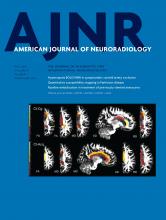Article Figures & Data
Tables
Characteristic 70 Years or Younger Older Than 70 Years P Value No. 135 134 Male 49% (66/135) 34% (45/134) .013 NIHSS (median) (IQR) 18 (14–20) 17 (13–20) .359 Prestroke mRS (categoric) <.001 0 81% (95/118) 63% (71/113) 1 15% (18/118) 17% (19/113) 2 3% (3/118) 19% (21/113) 3 2% (2/118) 2% (2/113) Occluded vessel .101 ICA 21% (28/130) 7% (22/132) M1 70% (91/130) 64% (84/132) M2 8% (10/130) 18% (24/132) M3 1% (1/130) 2% (2/132) Baseline ASPECTS (mean) 8.1 ± 1.9 (133) 8.4 ± 1.4 (133) .207 IV-tPA 63% (77/123) 58% (70/121) .513 Baseline serum glucose level (mean) 127 ± 56 (130) 126 ± 56 (129) .865 Atrial fibrillation 27% (36/135) 51% (68/134) <.001 Hypertension 53% (72/135) 74% (99/134) <.001 Coronary artery disease 21% (29/135) 25% (34/134) .474 Diabetes 19% (25/135) 19% (25/134) 1 Hyperlipidemia 46% (62/135) 39% (52/134) .267 Peripheral artery disease 1% (2/135) 0% (0/134) .498 Smoking 24% (32/135) 4% (5/134) <.001 Prior stroke or TIA 13% (17/135) 25% (34/134) .008 Note:—IQR indicates interquartile range.
70 Years or Younger Older Than 70 Years P Value No. of Solitaire passes (mean) 1.8 ± 1.0 1.7 ± 1.0 .420 Time from symptom onset to hospital arrival 178 (98–265) 172 (68–245) .263 Time from groin puncture to balloon guiding catheter 11 (6–17) 12 (8–17) .12 Time from symptom onset to groin puncture 253 (205–322) 255 (185–323) .714 Time from groin puncture to reperfusion 46 (28–68) 42 (32–70) .714 TICI 2b–3 87% (117/135) 83% (111/134) .400 General anesthesia 67% (90/135) 65% (87/134) .763 Conscious sedation 29% (39/135) 28% (38/134) .763 Note:—IQR indicates interquartile range.
↵a All times are given as median minutes with IQR in parentheses.
70 Years or Younger Older Than 70 Years P Value Complication Symptomatic intracerebral hemorrhage 4% (5/135) 1% (2/134) .447 PH-1 intracerebral hemorrhage 2% (3/135) 1% (2/134) 1 PH-2 intracerebral hemorrhage 2% (3/135) 0% (0/134) .247 SAH intracerebral hemorrhage 1% (2/135) 2% (3/134) .684 IVH intracerebral hemorrhage 0% (0/135) 1% (1/134) .498 Any intracerebral hemorrhage 19% (25/135) 14% (19/134) .410 Vasospasm 27% (36/135) 17% (23/134) .077 Device-related AE 16% (21/135) 14% (19/134) .864 Outcome at 90 days All-cause mortality 8% (11/135) 12% (16/134) .318 mRS 0–2 64% (87/135) 12% (59/134) 0.318 Note:—PH-1 indicates parenchymal hematoma type 1; PH-2, parenchymal hematoma type 2; IVH, intraventricular hemorrhage; AE, adverse events.
Age Groups (yr) TICI 2b–3 TICI 0–2a Unadjusted OR (95% CI) Adjusted OR (95% CI) 70 or younger 67.5% (79/117) 44.4% (8/18) 2.6 (0.95–7.11) 4.82 (1.32–17.63) Older than 70 49.5% (55/111) 17.4% (4/23) 4.66 (1.49–14.59) 7.32 (1.73–30.99) ↵a The frequency of good clinical outcome is given according to age and TICI scores. For each age group, the OR is provided for good outcome in patients with successful reperfusion (TICI 2b–3) vs unsuccessful reperfusion (TICI 0–2a).
Age (yr) TICI 0–2a TICI 2b–3 P Value 60 or younger 75.0% (9/12) 87.0% (47/54) .372 61–70 50.0% (3/6) 73.0% (46/63) .346 71–77 46.7% (7/15) 74.1% (43/58) .061 78 or older 25.0% (2/8) 67.9% (36/53) .044 - Table 6:
Predictors of good outcome following mechanical thrombectomy in younger and older patients
Variable 70 Years or Younger Older Than 70 Years OR 95% CI P Value OR 95% CI P Value Afib 0.53 (0.18–1.61) .265 1.5 (0.58–3.90) .407 Baseline ASPECTS 1.16 (0.91–1.49) .222 1.06 (0.73–1.54) .752 Baseline NIHSS 0.88 (0.78–0.99) .033 0.86 (0.78–0.96) .006 Female 1.28 (0.49–3.33) .617 1.07 (0.39–2.97) .898 HTN 0.57 (0.20–1.63) .296 1 (0.34–2.95) .995 ICA 4.01 (0.88–18.33) .073 0.35 (0.08–1.44) .145 IV-tPA 1.06 (0.38–2.96) .915 2.32 (0.89–6.06) .086 Prestroke mRS score 0.53 (0.26–1.11) .092 0.64 (0.38–1.10) .104 TICI 2b–3 4.82 (1.32–17.63) .018 7.32 (1.73–30.99) .007 Note:—Afib indicates atrial fibrillation; HTN, hypertension.












